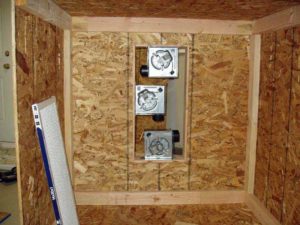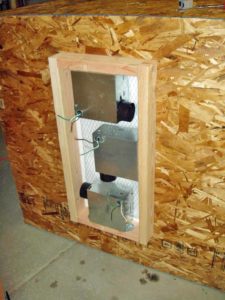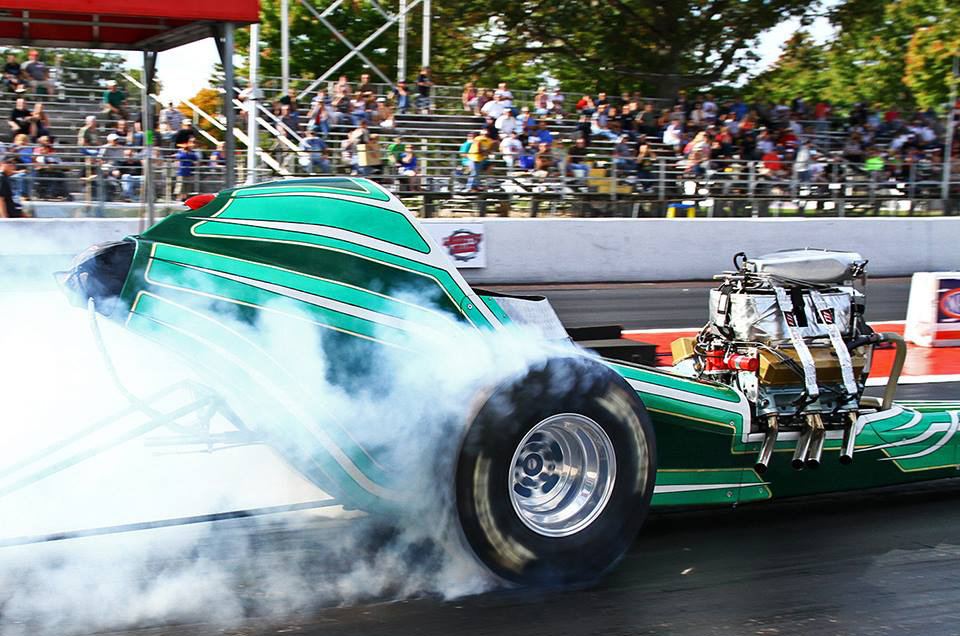Powder Coat Part 9: Where to Powder Coat
Click image to see larger picture
This topic has more to do with what you do not want to do, than what to do.
You want to capture the excess powder that is not attracted to the object to be powder coated. If you were able to capture the unused powder and can keep it clean with no dust, you can reuse it. I do not save it. It is just not worth the risk of spraying a surface only to have specks of dust appear after the object is cured.
A clean work place is a happy work place. Keep dust particles down so they do not end up in your finished piece. This also reduces the potential for having to redo pieces because they have been contaminated by powder outside the spray booth. Eg., white air borne powder on an object powder coated black.
I was lucky in that I had a dedicated area set up for painting. This area far exceeded the requirements of containing the dust from powder coating. I now do very little painting, just an occasional spray can, when for some reason, I cannot powder coat.
If you spray powder coat in an open area of your shop, you will end up with powder all over the shop. As stated earlier, you do not want to breathe in the powder coating dust as the body cannot break it down. It is not harmful to the body in that it is not toxic and it is inert.
In order to keep the powder coating dust contained in the powder coating booth or area, the recommendation is to have air movement of 125 face feet per minute (FPM). To calculate the Cubic Feet per Minute (CFM) of the fans needed, take the area of the booth opening in feet (width x height) and multiply that by 125. For a 1×1 foot opening, you need fans that move 125 CFM as mounted in the booth. Keep in mind when looking at fans that they give the airflow when freestanding, and that you need to account for the loss in air flow from filters and ducting.
I did a search on the internet and came across these ideas. They are a little crude, but there are some good points and they do work.
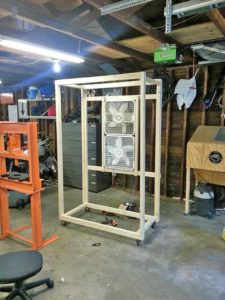 This is a frame on casters and the builder mounted some inexpensive window fans on the back of the frame. This might cause too high of an air flow, but with the fans turned all the way down it may be ok. The power coat material is very fine and it does not take a lot of air movement to make it “drift” in a direction. My fear here is that the fans would draw so much air that it might pull the powder off the surface to be powder coated.
This is a frame on casters and the builder mounted some inexpensive window fans on the back of the frame. This might cause too high of an air flow, but with the fans turned all the way down it may be ok. The power coat material is very fine and it does not take a lot of air movement to make it “drift” in a direction. My fear here is that the fans would draw so much air that it might pull the powder off the surface to be powder coated.
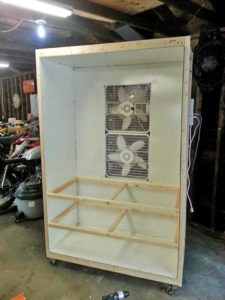 On the bottom of the cabinet, there is framing for shelves. The sides and back are made from a smooth sided material purchased to help reduce the powder sticking to the booth and allowing easier cleanup.
On the bottom of the cabinet, there is framing for shelves. The sides and back are made from a smooth sided material purchased to help reduce the powder sticking to the booth and allowing easier cleanup.
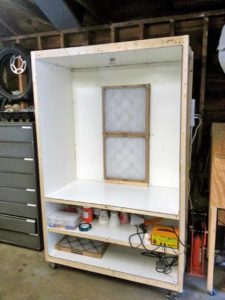 I assume the filters are removable as they will become clogged fairly quickly. He mounted a swiveling hook in the top of the cabinet that is grounded to the control unit which sits on a shelf in the bottom of the unit. I would have:
I assume the filters are removable as they will become clogged fairly quickly. He mounted a swiveling hook in the top of the cabinet that is grounded to the control unit which sits on a shelf in the bottom of the unit. I would have:
> Added doors or made drawers in the bottom of the unit to keep dust out
> Added hinged aprons to extend beyond the cabinet to help contain the dust
> Installed lights in the top of the cabinet
All in all, I like the idea. I would have just gone a little further.
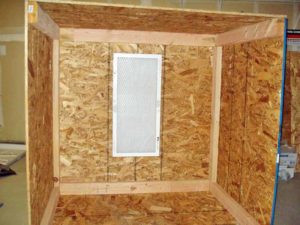 This is another variation on the same idea. A wooden box with filters and fans at the rear. For this one:
This is another variation on the same idea. A wooden box with filters and fans at the rear. For this one:
The inside should be smooth so that dust cleanup is easier and will not stick
> The 2X4s should be on the outside
It uses bathroom vent fans for ventilation. I like this, although it would be noisy as bathroom fans are not known for being quiet. I would add hoses from the exhausts of the fans with the exhaust blown out over the surface of water in buckets. This will collect any dust that got past the filter.